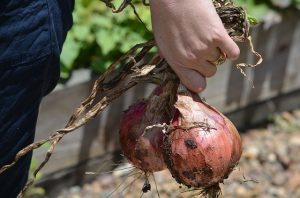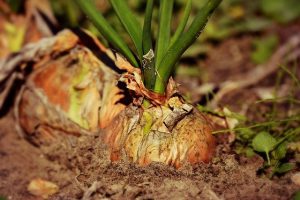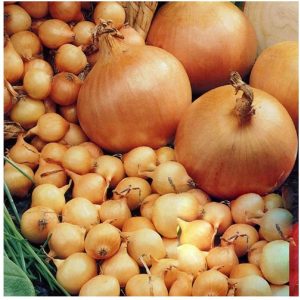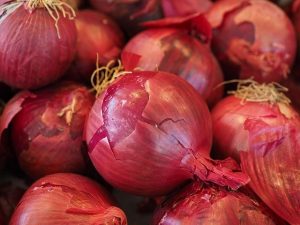Onions remain one of the most popular crops throughout the world and this author has been growing them regularly each year with generally great success compared to some vegetables. They are also a valuable base for most savoury dishes and there is increasing evidence for their health benefits, especially in combating heart disease and digestive issues.
Planting Onions
One of the most popular and probably easiest methods to obtain a good crop of onions is to grow them from sets rather than seeds. Onions require good drainage on an open site in very fertile soil. I prepare the ground in September but sets are started off as late as November. A good dressing of manure, compost with a general purpose fertiliser make for the ideal feed on soil which may well have been used for growing other crops. If the soil is light, then it not be firmed down but I prefer to have it flat and reasonably compact.
Over-wintering/Japanese Onion sets
I plant my sets from September to October when the clocks return to their winter settings so that they grow well over this period. Otherwise, when the conditions have returned to more benign settings, then plant sets of other varieties from mid-April to mid-May.
Onions can be planted to within a few centimeters of each other depending on the size desired. The closer the planting, the smaller the grown bulb so I choose my distances based on the size of the onion set. It is important to prevent the onion bed from drying out especially during hot summer weather which is around June/July when they grow really well. Exhibition onions need to be planted no nearer than 30 cm apart, but for smaller varieties this can be reduced to 18cm.
After planting out any bulbs, cover with protective netting or horticultural fleece to reduce bird attacks, insects and pest damage.
Sowing Seeds Of Onions
Sowing Seeds Indoors
Onion seed is best sown on the surface of John Innes Sowing Compost or another free-draining seed compost, in trays in the greenhouse or propagator. The sowing time is from December to early April but I prefer ideally January to February. Sow seeds about 1cm deep. Lightly cover with a sprinkling of vermiculite or some more compost. Germination takes about two weeks at a temperature of 10 to 15°C. The earliest is 10 days. The compost needs to be kept moist but never overwatered.
Following germination, the seedlings reach the ‘crook’ stage where they are about 4cm tall. These are transplanted like most seedlings into John Innes No2 compost usually in individual modules. Watering is only done when needed usually when the compost is partially dry.
Avoid Botrytis which devastates seedlings by ensuring they are well ventilated although the temperature needs to be kept constant.
The young plants can be transferred to a cold frame from mid- to late-March but ensure the crops are well hardened off before planting outdoors in April. The hardening off period is about 8 to 10 weeks after sowing. Plant out after the last frosts. Water them in well.
Leave 10 to 15cm between the plants and 30cm between the rows.
Sowing Outdoors
Where smaller onions are required, outdoor sowings can be tried in March to April. Choose a spot with form, well-drained soil that has been enriched with compost. Sow thinly in shallow drills 1cm- 1.5cm deep, with rows spaced about 30cm apart.
Thin, outdoor sowings when they large enough to handle to between 15-20cm apart. Some of the larger varieties will need about 30cm.

Growing On
Onions can be fed with a small amount of fertiliser, early in their growing season. Too much feed causes the onions to form thick necks with poor keeping quality. Mulching around the growing bulbs helps to conserve soil moisture and suppress weeds.
Marshalls produce an onion, garlic and shallot fertiliser for placing on recently-planted crops. It contains nutrients and various trace elements.
Any plants producing flower spikes need to have these removed as this implies bolting which is highly undesirable.
Harvest in August to September.

Storage
Onions store better when harvested with little growth left on the plant. The exhibition types are usually lifted 10 to 14 days prior to any showing. Dead and broken skin should be removed and then left to dry either in the Sun or in a warm dry area. Store all the onions in a cool but frost-free shed or garage. Cut the tops but leave enough for handling.
[Please note we are an affiliate marketing partner and will make a sales commission if you purchase any items through our affiliate links. Please read our affiliate disclosure]
Recommended Varieties
Spring Planting Small Onions From Seed: ‘Red Baron’, ‘Ailsa Craig’ ‘Golden Bear’, ‘Rijnsburger’.
Spring Planting Small Onions From Sets: ‘Rumba’, ‘Santero’, ‘Red Baron’ ‘Centurion’.
Autumn Planting Small Onions From Sets: ‘Radar’, ‘Red Baron’, ‘Shakespeare’, ‘Senshyu Yellow’, ‘Electric’.
cv. Ailsa Craig – large globed variety with a mild flavour and golden, straw-coloured skins. Traditional favourite for exhibition purposes. Purchase seeds from Johnsons.
cv. Bedfordshire Champion – a heavy cropping and very long storing cultivar which has yellow to light brown globes. Available from Mr Fothergills.
cv. Hybound. A relatively modern and high yielding early Rijnsbuger variety producing attractive brown bulbs. This onion has a straw-coloured, attractive outer skin with very good outer skin protection. Use for storing.
cv. Snowball. Sets are available from mid-December to March.
cv. Sturon. A reliable variety producing onions with thick brown skins. They store extremely well so the harvests last well into the Winter. Purchase seeds from Premier Seeds Direct.
cv. Stuttgart. A well established variety. Purchase seeds from Premier Seeds Direct.

cv. Walla Walla. A very large exhibition onion and a variety associated with France. Purchase seeds from Premier Seeds Direct.
Red Onions
cv. Red Baron. – A great red onion which is harvested young for salads as well as for more prominent salads. Purchase seeds from Premier Seeds Direct.

Leave a Reply